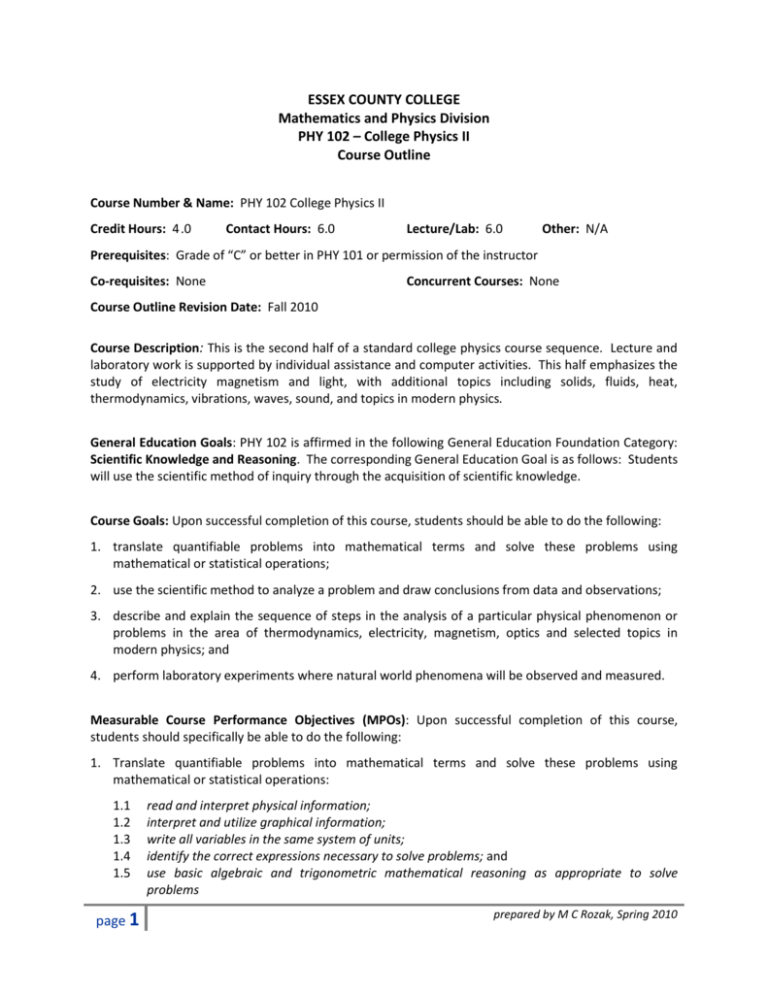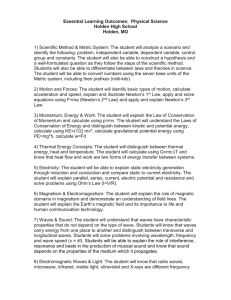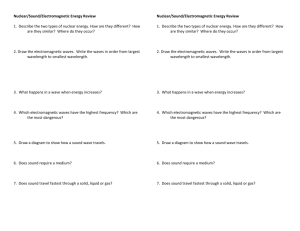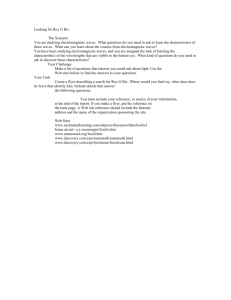
ESSEX COUNTY COLLEGE
Mathematics and Physics Division
PHY 102 – College Physics II
Course Outline
Course Number & Name: PHY 102 College Physics II
Credit Hours: 4 .0
Contact Hours: 6.0
Lecture/Lab: 6.0
Other: N/A
Prerequisites: Grade of “C” or better in PHY 101 or permission of the instructor
Co-requisites: None
Concurrent Courses: None
Course Outline Revision Date: Fall 2010
Course Description: This is the second half of a standard college physics course sequence. Lecture and
laboratory work is supported by individual assistance and computer activities. This half emphasizes the
study of electricity magnetism and light, with additional topics including solids, fluids, heat,
thermodynamics, vibrations, waves, sound, and topics in modern physics.
General Education Goals: PHY 102 is affirmed in the following General Education Foundation Category:
Scientific Knowledge and Reasoning. The corresponding General Education Goal is as follows: Students
will use the scientific method of inquiry through the acquisition of scientific knowledge.
Course Goals: Upon successful completion of this course, students should be able to do the following:
1. translate quantifiable problems into mathematical terms and solve these problems using
mathematical or statistical operations;
2. use the scientific method to analyze a problem and draw conclusions from data and observations;
3. describe and explain the sequence of steps in the analysis of a particular physical phenomenon or
problems in the area of thermodynamics, electricity, magnetism, optics and selected topics in
modern physics; and
4. perform laboratory experiments where natural world phenomena will be observed and measured.
Measurable Course Performance Objectives (MPOs): Upon successful completion of this course,
students should specifically be able to do the following:
1. Translate quantifiable problems into mathematical terms and solve these problems using
mathematical or statistical operations:
1.1
1.2
1.3
1.4
1.5
page 1
read and interpret physical information;
interpret and utilize graphical information;
write all variables in the same system of units;
identify the correct expressions necessary to solve problems; and
use basic algebraic and trigonometric mathematical reasoning as appropriate to solve
problems
prepared by M C Rozak, Spring 2010
Measurable Course Performance Objectives (MPOs) (continued):
2. Use the scientific method to analyze a problem and draw conclusions from data and observations:
2.1
2.2
2.3
analyze data to show the relationship between measured values and dependent variables;
explain how the results verify, or in some cases, do not seem to verify the particular hypothesis
tested in the experiment; and
communicate the results by writing laboratory reports using the computer
3. Describe and explain the sequence of steps in the analysis of a particular physical phenomenon or
problems in the area of thermodynamics, electricity, magnetism, optics and selected topics in
modern physics:
3.1
3.2
3.3
3.4
3.5
recognize the difference between temperature and heat, solve problems involving heat, and
apply the laws of thermodynamics to ideal gases and thermodynamic processes;
analyze and solve problems in electricity, including those involving Coulomb’s law, electric
fields, electric potential, and simple electric circuits;
analyze and solve problems in electromagnetism, including those involving magnetic fields,
magnetic forces, motion of charged particles in a magnetic field, Ampere’s law, magnetic flux,
and Faraday’s and Lenz’s laws
analyze and solve problems involving mechanical waves, sound waves, electromagnetic waves,
and geometrical and physical optics; and
describe the origins of quantum mechanics, the dual nature of light and particles, the
Uncertainty Principle and Bohr’s model of the atom, wave mechanics, and the structure of the
nucleus, radioactivity and nuclear energy
4. Perform laboratory experiments where natural world phenomena will be observed and measured:
3.1
3.2
3.3
use various appropriate equipment to measure and observe natural world phenomena;
work independently and also as member of a group; and
minimize errors in data collecting
Methods of Instruction: Instruction will consist of a combination of lectures, class discussions,
classroom demonstrations, laboratory experiments, board work, group work and individual study.
Outcomes Assessment: Test and exam questions are blueprinted to course objectives. Data is collected
and analyzed to determine the level of student performance on these assessment instruments in
regards to meeting course objectives. The results of this data analysis are used to guide necessary
pedagogical and/or curricular revisions.
page 2
prepared by M C Rozak, Spring 2010
Course Requirements: All students are required to:
1. Complete all homework assignments before each class.
2. Come prepared for each lab, having read the material ahead of time.
3. Perform all laboratory experiments, analyze data and write lab reports.
4. Prepare and present a research project on an approved topic in modern physics.
5. Complete all tests, exams, and presentations in class or make up missed tests, if permitted. These
include a minimum of 4 tests, 8 laboratory experiments and lab reports and an optional project
presentation.
Required Materials:
Textbook: Physics,3rd edition (ECC custom edition), by James S. Walker; published by
Pearson/Prentice Hall
Lab Manual: Lab Book for Physics 102 by M. C. Rozak and N. Lvov from the ECC bookstore
A notebook, ruler, protractor, pencils, scientific calculator, and graph paper (metric)
Methods of Evaluation: Final course grades will be computed as follows:
Grading Components
Homework and Quizzes
% of
final course grade
10 20%
Students will be expected to analyze and solve problems that
indicate the extent to which they master course objectives.
8 or more Laboratory Reports
10 20%
Students will be expected to show that they have read assigned
lab manual sections, can follow written procedures, measure and
record data, perform calculations and write reports including all
specified components.
4 or more Tests (dates specified by the instructor)
40 60%
Tests show evidence of the extent to which students meet the
course objectives, including but not limited to identifying and
applying concepts, analyzing and solving problems, estimating
and interpreting results and stating appropriate conclusions using
correct terminology.
Project Presentation (optional)
10 15%
The optional project presentation demonstrates a student’s
ability to work individually on conducting research and presenting
topics in modern physics.
NOTE: The instructor will provide specific weights, which lie in the above-given ranges, for each of the
grading components at the beginning of the semester.
page 3
prepared by M C Rozak, Spring 2010
Academic Integrity: Dishonesty disrupts the search for truth that is inherent in the learning process and
so devalues the purpose and the mission of the College. Academic dishonesty includes, but is not
limited to, the following:
plagiarism – the failure to acknowledge another writer’s words or ideas or to give proper credit
to sources of information;
cheating – knowingly obtaining or giving unauthorized information on any test/exam or any
other academic assignment;
interference – any interruption of the academic process that prevents others from the proper
engagement in learning or teaching; and
fraud – any act or instance of willful deceit or trickery.
Violations of academic integrity will be dealt with by imposing appropriate sanctions. Sanctions for acts
of academic dishonesty could include the resubmission of an assignment, failure of the test/exam,
failure in the course, probation, suspension from the College, and even expulsion from the College.
Student Code of Conduct: All students are expected to conduct themselves as responsible and
considerate adults who respect the rights of others. Disruptive behavior will not be tolerated. All
students are also expected to attend and be on time all class meetings. No cell phones or similar
electronic devices are permitted in class. Please refer to the Essex County College student handbook,
Lifeline, for more specific information about the College’s Code of Conduct and attendance
requirements.
page 4
prepared by M C Rozak, Spring 2010
Course Content Outline: based on the text Physics, 3rd edition, by James S. Walker & published by
Pearson/Prentice Hall and the lab manual Lab Book for Physics 102 by M. C. Rozak and N. Lvov from
the ECC bookstore
Class Meeting
(80 minutes)
1
2
3
4
5
6
7
8
9
10
11
12
13
14
15
16
page 5
Chapter/Section
CHAPTER 14 WAVES AND SOUND
14.1 Types of waves
14.2 Waves on a string
14.3 Harmonic wave functions
14.4 Sound waves
14.5 Sound intensity
Lab #1 Resonance: the Speed of Sound
14.6 The Doppler Effect
14.7 Superposition and interference
14.8 Standing waves
14.9 Beats
Lab #2 Standing Waves on a String
CHAPTER 16 TEMPERATURE AND HEAT
16.1 Temperature and the zeroth law of Thermodynamics
16.2 Temperature scales
16.3 Thermal expansion
16.4 Heat and mechanical work
16.5 Specific heats
16.6 Conduction, convection and radiation
Lab #3 Specific Heat
CHAPTER 17 PHASES AND PHASE CHANGES
17.1 Ideal gases
17.2 Kinetic theory
17.3 Solids and elastic deformation
17.4 Phase equilibrium and evaporation
17.5 Latent heats
17.6 Phase changes and energy conservation
CHAPTER 18 THE LAWS OF THERMODYNAMICS
18.1 The zeroth law of Thermodynamics
18.2 The first law of Thermodynamics
18.3 Thermal processes
18.4 Specific heats for an ideal gas: constant pressure, constant volume
Test #1 on Chapters 14, 16 & 17
prepared by M C Rozak, Spring 2010
Class Meeting
(80 minutes)
17
18
19
20
21
22
Chapter/Section
CHAPTER 19 ELECTRIC CHARGES, FORCES AND FIELDS
19.1 Electric charge
19.2 Insulators and conductors
19.3 Coulomb’s law
19.4 The electric field
19.5 Electric field lines
19.6 Shielding and charging by induction
19.7 Electric flux and Gauss’s law
CHAPTER 20 ELECTRIC POTENTIAL AND ELECTRIC POTENTIAL ENERGY
20.1 Electric potential energy and the electric potential
20.2 Energy conservation
20.3 The electric potential of point charges
20.4 Equipotential surfaces and the electric field
Lab #4 Resistance and Resistivity
23
CHAPTER 21 ELECTRIC CURRENT AND DIRECT-CURRENT CIRCUITS
21.1 Electric current
21.2 Resistance and Ohm’s law
24
Test #2 on Chapters 18, 19 & 20
25
26
27
Lab #5
21.3
21.4
21.8
Lab #6
28
29
30
31
32
33
page 6
Ohm’s Law
Energy and power in electric circuits
Resistors in series and parallel
Ammeters and voltmeters
Resistances in Series and in Parallel
CHAPTER 22 MAGNETISM
22.1 The magnetic field
22.2 The magnetic force on moving charges
22.3 The motion of charged particles in a magnetic fields
22.4 The magnetic forces exerted on a current-carrying wire
22.5 Loops of current and magnetic torque
22.6 Electric currents, currents, magnetic fields and Ampère’s law
22.7 Currents loops and solenoids
22.8 Magnetism in matter
CHAPTER 23 MAGNETIC FLUX AND FARADAY’S LAW OF INDUCTION
23.1 Induced electromotive force
23.2 Magnetic flux
23.3 Faraday’s law of induction
23.4 Lenz’s law
23.5 Mechanical work and electrical energy
23.6 Generators and motors
prepared by M C Rozak, Spring 2010
Class Meeting
(80 minutes)
Chapter/Section
34
Test #3 on Chapters 21, 22 & 23
35
36
37
38
39
40
CHAPTER 25 ELECTROMAGNETIC WAVES
25.1 The production of electromagnetic waves
25.2 The propagation of electromagnetic waves
25.3 The electromagnetic spectrum
25.4 Energy and momentum in electromagnetic waves
25.5 Polarization
CHAPTER 26 GEOMETRICAL OPTICS
26.1 The reflection of light
26.2 Forming images with a plane mirror
26.3 Spherical mirrors
26.4 Ray tracing and the mirror equation
26.5 The refraction of light
Lab #7 Law of refraction
26.6 Ray tracing for lenses
26.7 The thin-lens equation
26.8 Dispersion and the rainbow
43
CHAPTER 28 PHYSICAL OPTICS: INTERFERENCE AND DIFFRACTION
28.1 Superposition and interference
28.2 Young’s two-slit experiment
28.3 Interference in reflected waves
28.4 Diffraction
28.5 Resolution
28.8 Diffraction grating
Lab #8 Diffraction and Interference
44
Test #4 on Chapters 25, 26 & 28
41
42
47
48
49
page 7
CHAPTER 30 QUANTUM PHYSICS
30.1 Black body radiation and Planck’s hypothesis of quantized energy
30.2 Photons and the photoelectric process
30.3 The mass and momentum of a photon
30.4 Proton scattering and the Compton Effect
30.5 The de Broglie hypothesis and wave-particle duality
30.6 The Heisenberg Uncertainty Principle
30.7 Quantum tunneling
CHAPTER 31 ATOMIC PHYSICS
31.1 Early model of the atom
31.2 The spectrum of the hydrogen atom
31.3 Bohr’s model of the hydrogen atom
prepared by M C Rozak, Spring 2010
Class Meeting
(80 minutes)
50
51
52
Chapter/Section
31.4
31.5
31.6
31.7
de Broglie waves and the Bohr model
The quantum mechanical hydrogen atom
Multielectron atoms and the periodic table
Atomic radiation
CHAPTER 32 NUCLEAR PHYSICS AND NUCLEAR RADIATION
32.1 The constituents and structure of the nucleus
32.2 Radioactivity
32.3 Half-life and radioactive dating
32.4 Nuclear binding energy
32.5 Nuclear fission
32.6 Nuclear fusion
32.7 Practical applications of nuclear physics
32.8 Elementary particles
32.9 Unified forces and cosmology
53
54
Project Presentations (optional)
Project Presentations (optional)
55
Test #5 on Chapters 30, 31 & 32 (optional – required for students who did not
do project presentations)
page 8
prepared by M C Rozak, Spring 2010








